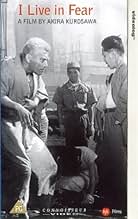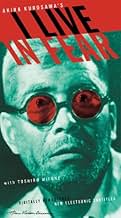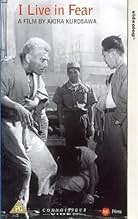An aging Japanese industrialist becomes so fearful of nuclear war that it begins to take a toll on his life and family.An aging Japanese industrialist becomes so fearful of nuclear war that it begins to take a toll on his life and family.An aging Japanese industrialist becomes so fearful of nuclear war that it begins to take a toll on his life and family.
- Awards
- 1 nomination total
- Yamazaki, Yoshi's husband
- (as Gen Shimizu)
Featured reviews
I should have known better. Part of Kurosawa's genius in his great middle period (1950-1965) is that he refuses to insist on anything. He fairly presents a series of events and invites us to decide what, if anything, they mean.
Everyone in this film has a point. No one here is really a villain. Even those who are jerks (notably the second son, Jiro) are really trying to do the right thing. And the film reminds me a little of THE CAINE MUTINY in that it very artfully moves our sympathies in one direction for most of the film before presenting us with events that make us wonder if we were wrong.
Toshiro Mifune gives a fine performance as Nakajima, but to tell the truth, I wish Kurosawa had given the role to Takashi Shimura, not only because I think Shimura would have played the role even better, but because it would have given him one more tour-de-force leading role in a Kurosawa film, coming directly after IKIRU and SEVEN SAMURAI. Granted, though, that such a move probably would have caused problems with both Toho and Mifune.
Naturally his adult children and even his wife have no desire to move from their comfortable Tokyo home and try to get him declared mentally incompetent. Takashi Shimura is a dentist serving as conflicted judge on the court mediation panel. This excellent look into the personal psychology of 1950s nuclear paranoia is a huge step above the numerous propaganda films of the era and an ideal complement to the numerous allegorical sci-fi horror films from the same period (especially GODZILLA, from the year before and also starring Takashi Shimura), as well as some of the more interesting Cold War post-apocalyptic films like WORLD WITHOUT END (1956) and PANIC IN YEAR ZERO (1962).
Here we have seventy-year old foundry owner Nakajima played by thirty-five year old Toshiro Mifune, who is so obsessed with the threat of a nuclear holocaust that he plans to sell up and move his extended family, including two mistresses and their offspring, to South America. His family's attempts to have him declared mentally incompetent have the most dire and tragic consequences for them all.
Apart from his ill-conceived and interminable version of Gorky's 'Lower Depths', the consistent quality of Kurosawa's work throughout the fifties and sixties is both staggering and unparalleled.
Unsurprisingly this gloomy opus was a commercial failure and had to wait six years before being shown at the Berlin Film Festival. A further six years were to elapse before its theatrical release in America. It still remains mystifyingly underrated.
All of the acting kudos has been reserved of course for Mifune who is mesmerising in the role. It is such a pity that he and Kurosawa parted company in the late sixties as theirs was a partnership made in heaven.
Every character in this is beautifully drawn and one cannot fail to mention Kurosawa regular Takashi Shimura as domestic mediator Harada who is consumed with guilt and remorse over Nakajima's fate. This comes three years after his own stunning performance in 'Ikiru' for the same director. Ironically he appeared a year earlier in another film dealing with fear of a nuclear holocaust, 'Godzilla', which naturally cleaned up at the box office.
The touches of a master film maker are here in terms of sound effects, editing and grouping of actors. The constant mopping of brows and waving of fans captures perfectly the unbearable heat and of course a Kurosawa film would not be complete without a torrential downpour or two.
This is an immensely powerful work which raises so many issues not least of which is the thin dividing line between rational/irrational behaviour. Does Nakajima 'go too far'? Many would say 'yes'.
It is Nobuo Nakamura as the psychologist who has the most telling speech when asking: "Is he crazy or are those who are unperturbed in an insane world the crazy ones?"
The final shot of the disconsolate Harada trudging down the stairs of the asylum whilst one of Nakajima's daughters, with child on back, walks up to visit her deranged father, is one of cinema's most devastating endings.
In a world presently paralysed by fear and paranoia this timeless film is ripe for rediscovery.
Did you know
- TriviaToshiro Mifune was 35 years old when he played the role of a 70 year old.
- Quotes
Domestic Court Counselor Dr. Harada: His only fault is going too far. But his anxiety about the bomb is something we all share. Mr. Araki, Mr. Hori, Miss Tamiya -- you all know the feeling. Isn't that true? We just don't feel it quite as strongly. We don't build underground shelters or plan to move to Brazil. But can we claim that the feeling is beyond comprehension? The Japanese all share it, to greater or lesser degrees. We can't dispense with it so easily by just saying he went too far.
- ConnectionsFeatured in Mark Kermode's Secrets of Cinema: Disaster Movies (2019)
- How long is I Live in Fear?Powered by Alexa
Details
- Release date
- Country of origin
- Language
- Also known as
- Chronique d'un être vivant
- Filming locations
- Toho Studios, Tokyo, Japan(Studio)
- Production company
- See more company credits at IMDbPro
Box office
- Gross US & Canada
- $46,808
- Opening weekend US & Canada
- $15,942
- Jul 28, 2002
- Gross worldwide
- $47,023
- Runtime1 hour 43 minutes
- Color
- Sound mix
- Aspect ratio
- 1.37 : 1
Contribute to this page



































